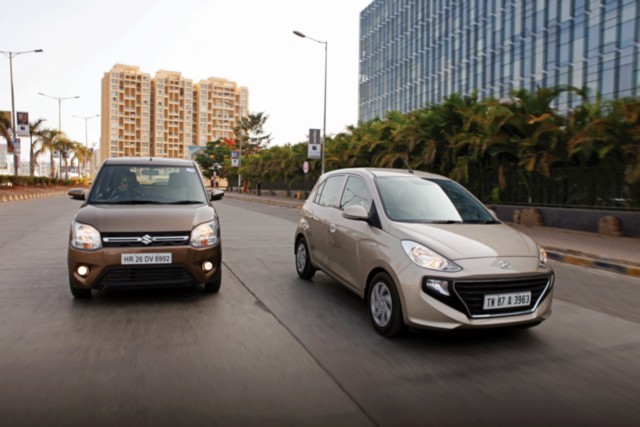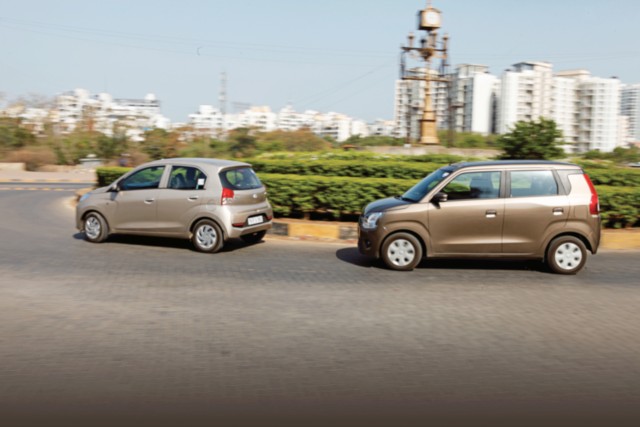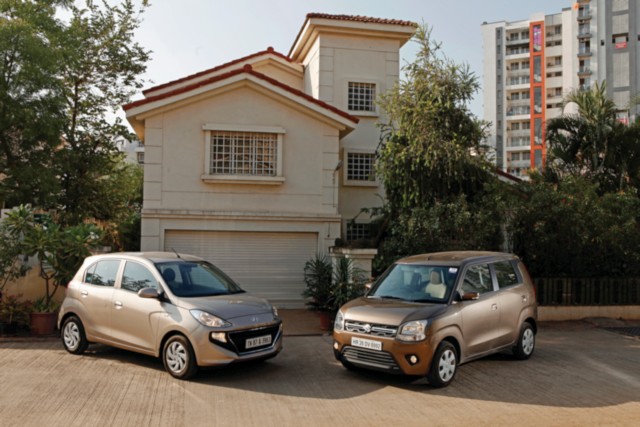
The new WagonR ZXi AGS weighs in at 845 kg, holds 32 litres of juice, and packs, for the first time, a K12 series 1.2-litre, four-cylinder petrol engine that makes 83 PS and 113 Nm. This is the most powerful WagonR ever offered and being paired with their proven “Auto Gear Shift” (AGS) automated manual transmission means it makes good use of that output. Like the Ignis I spent considerable time with, the AGS may seem like a slow-thinking automatic but more time spent with it reveals that it has very predictable shift characteristics and that makes it more efficient in harnessing the engine’s power-band and balancing urgent acceleration and coasting in a higher gear for maximum fuel economy. Speaking of which, in the real world, we saw over 13 km/l to a litre in stop-go city traffic and around 19 km/l on the somewhat less crowded highway.
Believe it or not, the WagonR has a fantastic soundtrack for the engine size. It has a rather rorty exhaust note under acceleration. With that sort of output, it even set some commendable acceleration times: 100 km/h from zero was dismissed in 13.3 seconds and it went past the quarter-mile marker in 19 seconds flat. At highway speeds, it felt stable and was reasonably reassuring under hard braking as well. The steering feel under braking is adequate; however, on the move it feels numb and lacks pretty much any sort of feedback. When taking turns at low speed, it doesn’t even return to the zero position and continues on its trajectory needing manual input to straighten itself out. That apart, it feels decent to drive and the engine note adds a touch of excitement to what is otherwise a thoroughly function-biased, value-for-money package. Other features definitely worth mentioning are the quick lane-change indicator — where one quick flick of the indicator stalk brings about three flashes of the turn-indicators; extremely useful on the highway — and the speed-sensitive auto door locks. The Santro doesn’t have either of these features.
The Hyundai Santro, then, is a credible city car, but, like its fellow tall-boy, the WagonR, is prone to body-roll in sharper bends even at moderate speeds — the kind where any bags on the rear seat change side. The 235-litre boot is enough for luggage for trips spanning a few days and the 35-litre fuel-tank holds more than enough juice for a weekend getaway. The Santro’s strong points are definitely its well-set-up suspension, cabin sound-deadening and the smoother shifting automated transmission. While head-nod is less in this nice, in-house engineered AMT unit, over time I have found it to be less predictable than the one Maruti have used in multiple cars, the WagonR included. As such, the Santro performs better at lower and consistent speeds in the city that don’t require urgent acceleration. Panic braking, too, is not something it takes in its stride. It likes to be driven in a relaxed manner and the transmission rewards you if you have a smooth driving style. The three-valve engine, too, likes things a little relaxed and begins to sound gruff when the revs are piled on. It will do the job up there, but it feels like it’s something it doesn’t really want to do; almost similar to sounds I make in response to conversations at six in the morning when I’d rather be asleep.
In the powertrain department, the WagonR gets my vote as it’s the more versatile of the two, but in terms of overall performance and relaxed refinement, the Santro is the quieter car, the cabin sound-deadening is much better and it’s better built, too, all of which make a more convincing case for the made-in-Chennai Korean.

Verdict
The Maruti Suzuki WagonR is a versatile car that offers several choices. Leave this top-end 1.2 ZXi AGS apart for a bit and you can also have it with a 1.0-litre three-cylinder petrol engine with 68 PS and 90 Nm in a choice of three trims from Rs 4.39 lakh (ex-showroom) for the base LXi manual. There’s a VXi manual for 50k more and even an AGS model for Rs 5.31 lakh. The 1.2-litre engine is available in four variants starting from Rs 4.84 lakh for the manual VXi and another 47k for the VXi AGS. The top-spec ZXi manual is priced at Rs 5.49 lakh, or 47k less than the ZXi AGS we’ve tested here. The variant structure balances features and value extremely well and, unlike the competition, you don’t need to get the absolute top-spec to be rewarded with some very usable everyday equipment.
The Hyundai Santro is available with just one engine but offers a choice of five manual variants and two Auto variants. The manual range begins with the D-Lite variant at Rs 3.90 lakh (ex-showroom) but it must be noted this is a bare-bones trim without an a-c. Each successive variant is priced roughly Rs 30k-40k higher. The Smart Auto transmission is also available in the Magna variant at Rs 5.21 lakh, or 39k less than the Sportz variant tested here.
All said and done, both cars have their plus points and minus points and are far from perfect. The Maruti Suzuki WagonR is a compelling proposition in terms of features, but the Hyundai Santro shines brighter simply because the quality of materials and the robust feel of everything inside the cabin and the level of sound deadening employed lend it that overall feel-good factor which isn’t evident in the feature-rich WagonR.
Need to Know – Hyundai Santro 1.1 MPI Sportz Smart Auto
Price: Rs 5.60 lakh (ex-showroom)
Engine: 1,086 cc, in-line four, 12V SOHC, petrol
Max Power: 69 hp @ 5,500 rpm
Max Torque: 99 Nm @ 4,500 rpm
Transmission: Five-speed automated manual, front-wheel drive
Suspension: MacPherson strut front, torsion beam rear
Weight: 850 kg (estimated)
Acceleration (0-100 km/h): 19.37 seconds
Fuel Economy: 14 km/l city, 19 km/l highway, 15.25 km/l overall
Need to Know – Maruti Suzuki WagonR 1.2 ZXi AGS
Price: Rs 5.96 lakh (ex-showroom)
Engine: 1,197 cc, in-line four, 16V DOHC, petrol
Max Power: 83 hp @ 6,000 rpm
Max Torque: 113 Nm @ 4,200 rpm
Transmission: Five-speed automated manual, front-wheel drive
Suspension: MacPherson strut front, torsion beam rear
Weight: 845 kg
Acceleration (0-100 km/h): 13.36 seconds
Fuel Economy: 13.5 km/l city, 19 km/l highway, 14.88 km/l overall





















Leave a Reply